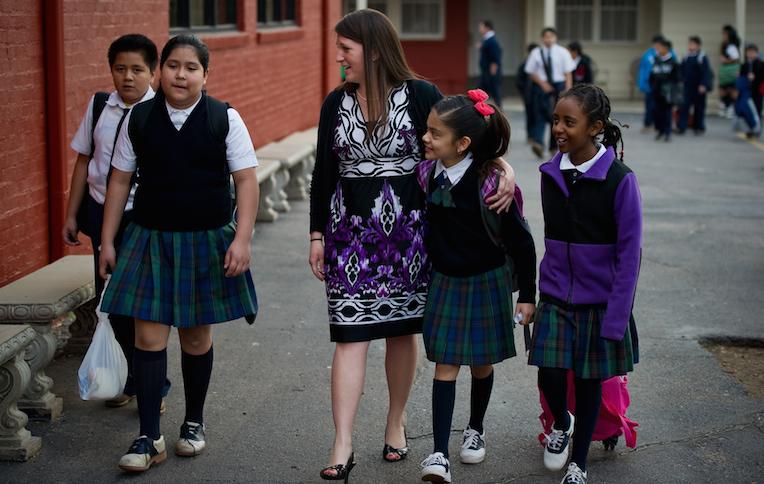A veteran teacher summed up the challenge for today’s teachers in a Washington Post story about poverty’s ravaging effects in America’s classrooms. Besides teaching, she said, they have to serve as “counselor, therapist, doctor, parent, [and] attorney.”
That’s one diagnosis underlying a concept called “full-service community schools.” The Washington, D.C.-based Coalition for Community Schools describes this concept as a set of partnerships between a school and other community resources that integrates academics with an array of services, supports, and opportunities to improve student learning. According to the Coalition, about 5,000 community schools currently assemble and host these partnerships in various ways.
“A mantra within the community schools movement is, ‘no two alike,’ which emphasizes how each one responds to the specific needs and assets of the community through collaborations with health care providers, social service agencies, and other organizations serving at-risk children and families,” said Andrew Remick, a Visiting Fellow at Notre Dame’s Institute for Educational Initiatives.
“In general, these schools report an impressive list of benefits for both students and the school community,” Remick said. “Test scores and attendance rates are higher, and the students have better access to health care and more engagement in school activities. There’s also higher teacher and parent engagement, and educators say they can devote more time to instruction thanks to the additional supports that address students’ non-academic needs.”
In light of these metrics of human well-being, at least one category of community schools deserves a closer look. Catholic schools formally adopting the model number only in the dozens, with approximately 20 belonging to a Boston-based initiative called “City Connects in Catholic Schools.”
Boston College’s Lynch School of Education and its Center for Optimized Student Support have helped to support this local group of inner-city Catholic elementary schools since about 2008. A few schools in southern Ohio have also adopted the model.
Catholic educators familiar with the operations in Boston schools say the structure works well, and the overall concept of a school as a neighborhood hub of services dates back at least to the 1980s when several contemporary models began to emerge, such as the Children's Aid Society Community Schools and "Beacon” community centers, both based in New York City; “City Connects” in Boston; and the Virginia-based Communities in Schools, which has affiliates in 26 states.
Even without adopting these models, Catholic schools may have developed ways to provide what “City Connects” calls “optimized student support,” said Remick. “Holistically serving children and their families is part of the DNA of a Catholic school community.” But the structure can make a difference, and educators in Boston say their schools have learned and benefited.
“We do develop the whole child, including the faith component,” said Maryann Manfredonia, principal of East Boston Central Catholic School, which partners with City Connects. The specific structure and protocols of this community school model carry a price tag but are “a natural fit” with her team of educators.
Daily challenges seem inevitable at East Boston Central Catholic, being the only parochial school in that disadvantaged section of Boston, now serving a largely Latino student population. It benefits from an array of services, such as community health centers, other medical experts, social service agencies, and local law enforcement.
“It does take a village,” said Sr. Patricia McCarthy, C.S.J., referring to the need for partnerships that both tap into government-funded support and maximize collaborations within school walls. McCarthy, a former principal of a Catholic school, testifies she saw the “City Connects” approach yield dividends, academically and otherwise, for students, teachers, and the school.
“Behavior problems were reduced or eliminated, and teachers were able to spend their time dealing with the academics and the faith life of the school because we already knew who needed some help,” said Sr. McCarthy.
The key is good teamwork starting inside the school, she explained. A principal sets the tone by encouraging teachers’ cooperation. Even more vitally, teachers work closely with an on-staff counselor or “school site coordinator,” who often has to be shared by two Catholic schools because of tight budgets.
A centerpiece of the “community schools” model, this coordinator works with every teacher to harvest insights into every student—test scores, medical issues, behavioral problems, and more. Coordinators update the information digitally, and use it to identify children who need special attention. As Sr. McCarthy observed, information leads to action: the coordinator reaches out to all the local resources best suited to address each child’s circumstances.
“It takes everyone working together—the principal, faculty, parents, and students,” said Sr. McCarthy.
Manfredonia pointed out that a well-trained coordinator who knows the community’s resources, shares best practices with others coordinators, and stays at a school for years can create change as an integral colleague.
The non-academic obstacles to learning cited in the aforementioned Washington Post story of Jan. 16, 2015 cry out for positive change. The article highlighted a Southern Education Foundation study that found a majority of U.S. public school students now come from families in poverty.
Supporters of a full-service approach cite one big problem restraining the strategy’s adoption in inner-city Catholic schools.
“Funding is always a very difficult issue,” said Manfredonia. Generous assistance from Boston’s Catholic Schools Foundation allowed Catholic schools to hire coordinators as problem-solvers during the start-up years, but ongoing employee costs bump up against strained budgets.
Remick said full-service community school models offer a constructive way for Catholic schools to respond to the myriad out-of-school factors impacting student learning. “Certainly there are many Catholic schools that already connect their students and families with additional resources even if they do not call themselves a ‘full-service school.’ Nevertheless, a better awareness of these strategies among Catholic educators may open doors to new funding sources and opportunities for partnerships with local agencies to provide more effective support.”
 Alliance for Catholic Education
Alliance for Catholic Education
